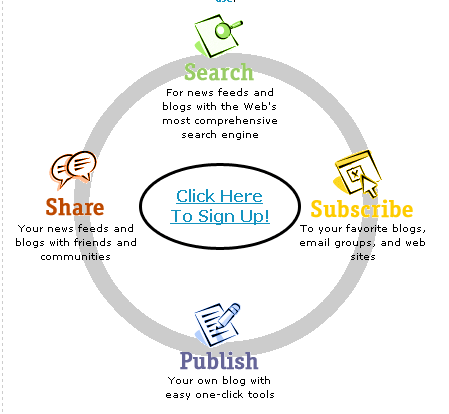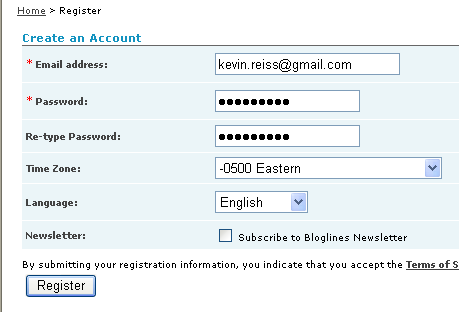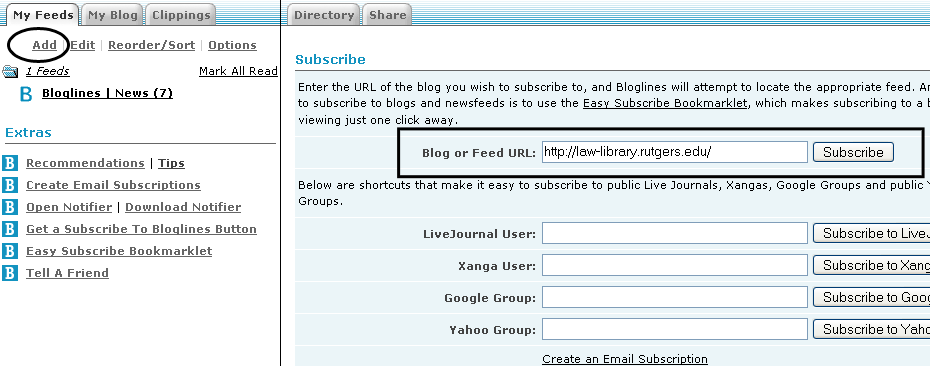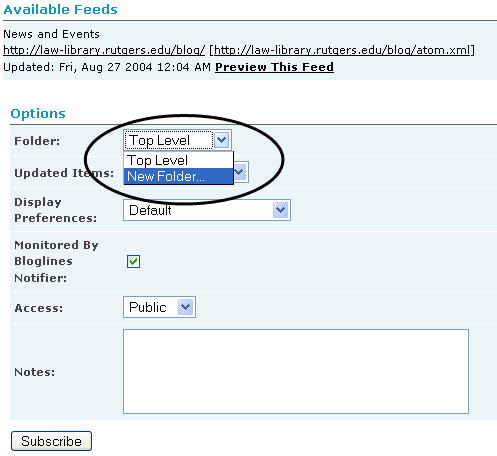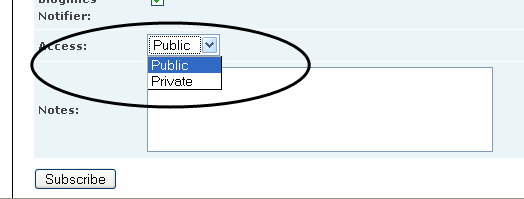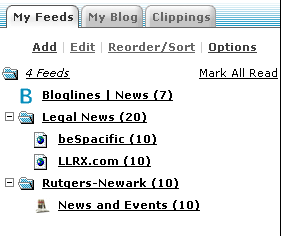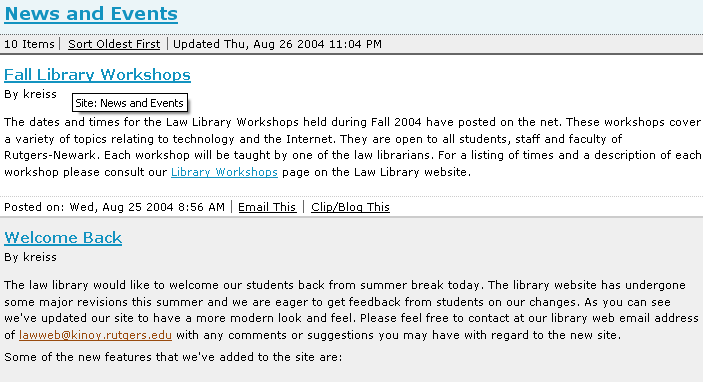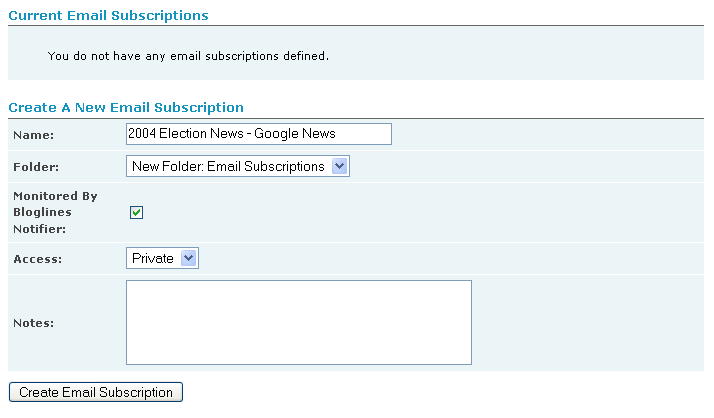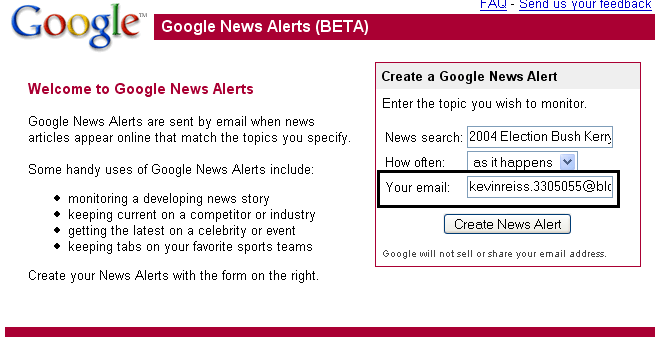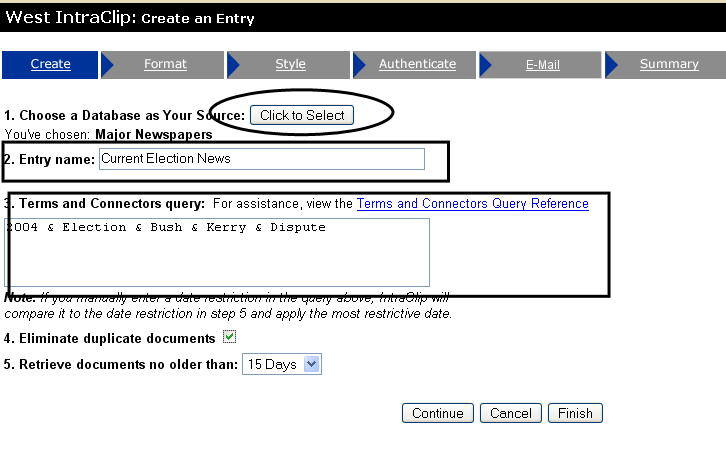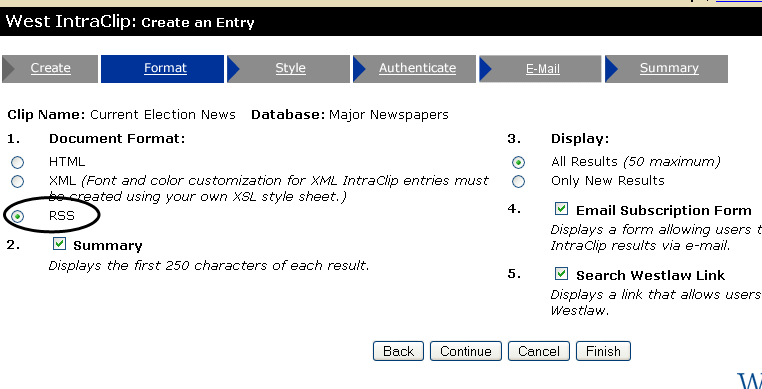Introduction to Blogs and RSS
- What is a Blog?
- Blog Vocabulary
- Blog-related Tools
- Finding Blogs
- Legal Blogs
- Using Bloglines
- Subscribing to Blogs
- Reading Feeds
- Subscribing to Database Feeds
- Subscribing to Mailing Lists using Bloglines
- Using Westlaw Intraclip for RSS
Rutgers-Newark Law Library - Spring 05
by Kevin Reiss
What is a Blog?
Blog is a shortened version of the word Weblog. A Weblog is a structured collection of information items or postings arranged in chronologically order. The material posted on a blog can take any form or content. It can be a collection of a person's thoughts on a particular, a list of newly added articles with abstracts for a particular journal, or a list of the current results of a particular query to a database. RSS, short for Rich Site Sumarry, is the name of the file format that blogs are expressed. The structured RSS format enables users to subscribe to a blog and recieve automatic updates about new content and additions to a blog.
Blogs are of growing interest to consumer and publishers of legal information in both the academic and commercial spheres. A recent LLRX article discusses the blog's emergence in the Legal World. They are used to publish news, articles, facilitate group collaboration, personal reflections, and political observations. Some databases or search engines allow users to create blogs that contain the most recent results of a particular query, allowing users to be notified on new items that are relevant to their query.
RSS, the technology behind blogging, is becoming an attractive alternative to mailing lists and email alerts. Information publishers, especially news organizations, are using blogs as a means to push out their newest information to users. CNN, yahoo, and Google News all allow individuals to subscribe to blogs that contain the latest news stories. Government is starting to become an important user of RSS according to a recent LLRX article. Blogs are also used by online communities for discussion. For example, you can receive postings to a yahoo group as a blog.
Our Law Library also maintains a blog that displays the current news about and events happening at the library. It can be found at http://law-library.rutgers.edu/blog.
How do they Work?
Let's look at a popular legal news blog to find out how the technology controls a blog works, JURIST's Paperchase [http://jurist.law.pitt.edu/paperchase/]. JURIST displays the most recent postings or "blogs" in chronological order, starting with the most recent item. The JURIST homepage is a typical web page that anyone can read by pointing a web browser at it. You can also see an icon, directing you to subscribe to the JURIST RSS Feed, this is the actual file that stores all of the information displayed in any given blog. If you follow this link you will see a simple structured file. The structure of this file allows programs designed for reading blogs, called aggregators to automatically process the information stored in the RSS file. RSS, which stands for Really Simple Syndication, is the technology that gives blogs their power and flexibility as a tools for communicating any type of information.
An RSS feed is constructed using one of the different varieties of blogging software available to users that allows one to author a blog. Most of these pieces of software consist of simple web forms into which users enter their content, and then add their new composition to the existing postings by submitting the form. The blogging software adds the new post to the HTML version of the blog and the RSS version.
Users who identify a blog they are interested in, then take note of the URL of a blog's RSS feed which they supply to their aggregator. Once they do this the user only has to launch his or her aggregator program and all the information that is present in the blog's he or she has subscribed to is brought to their desktop. When new items are added to a blog, the aggregator lets the user know automatically, one does not ever need to browse to the blogs website in order find out if new content is available. In this document we will show you how to use a free web-based aggregator called bloglines.
Blog Vocabulary
- RSS Feed
- This is the technology that provides the backbone for blogging. It is a triumph of simplicity and power. The acronym stands for Really Simple Syndication. While there a number of different dialects of RSS at their core they are all the same. An RSS document is a structured file encoded in XML, this allows easy machine processing and reading of their content. Each entry in a blog is recorded in feed along with relevant metadata about the entry: title, author, time of creation. Any RSS-enabled aggregator should be able to process any of the different dialects of RSS. To see what one looks like see the law library RSS Feed.
- XML
- XML is an international recommendation specifying how to create a markup languages to encode structured information. XML is published by the W3C, the World Wide Web Consortium. The W3C is responsible for HTML, the markup language that most documents on the Internet use. All RSS feeds are encoded as XML. Since XML is a universally supported computing standard RSS Feed can be read on any computing platform by any program capable of reading text files, this includes all Internet Browsers, Word Processing Programs, and text editors like MS Windows Notepad.
- Atom
- A new emerging RSS format that attempts to unify all of the different RSS formats that have emerged.
- Feed, RSS, RSS Feed, XML Feed
- Slang terms for an RSS or Atom document that one can subscribe to with an aggregator.
- Aggregator
- A program that allows a user to subscribe to, monitor, read, and manage their blog subscriptions. These can be web-based applications, standalone desktop programs, or plug-ins to popular email programs like Microsoft Outlook.
- RSS Feed Reader, RSS Reader, Feed Reader
- Other terms used to describe an aggregator.
- Syndication
- The incorporation of content provided as RSS feed into another document on the web. The use of the legal news feed from JURIST on the law library homepage is an example of syndication.
- Blogging Software
- Software that allows one to publish a blog. It produces and stores the RSS feed that contains the content of a blog. The look and organization of the HTML version of a blog postings is often customizable using such software. This software is almost always web-based.
- Subscription
- A blog that have directed your aggregator to monitor and inform you of recent entries.
- Blogroll
- A list of other blogs that the publisher of particular blog subscribes to. A blogroll is often published as a collection of links on the homepage of person's blog. For example here are my current subscriptions.
- Trackback
- If a posting on a blog refers to a posting on a different blog, the referring blog can send a trackback to the original blog. This notifies the original blog that another blog has referred to it, the original blog, if configured accordingly, can then create a link to the referring post as an addendum to the original.
- Ping
- When a blogger trackbacks to another blog, ping is the term used to describe the process on sending out the signal of a trackback sent to other blog.
- Podcast
- A Podcast is a popular new method for delivering audio content using RSS. The audio content is delivered as an mp3 file that can downloaded to one's computer. Audio providers that range from news organizations, Internet Radio stations, and Public Radio stations. An aggregator that is aware of podcasts will allow you to subscribe a podcast and will then automatically download new mp3 content to your computer. This content can then be listened to at your leisure or transferred to your mp3 player for use offline. The term "podcast" refers to the process of moving the content to an IPOD or another mp3 player. Most aggregators can be conferred to automatically transfer podcast content an mp3 player when it is plugged into a computer. For an exmaple of some news-related podcasts check out NPR and WYNC podcasts.
Blog-related Tools
Aggregators
Low-Cost or Free RSS Aggregators/Feed Readers
- Bloglines
- Free web-based service. Only a valid email account required to use.
- Feed Demon
- Low-Cost standalone desktop RSS Aggregator
- Mozilla Thunderbird
- Free standalone aggregator and email program with an interface similiar to Microsoft Outlook and Eudora.
- NewsGator
- Aggregator that runs as a plug-in in Microsoft Outlook.
- NetNewsWire
- Low-cost, high-quality, RSS Aggregator for the Macintosh.
Blogging Software
- Blogger
- Free, run by Google, web-based service that hosts and allows users program. If you use blogger's web space google adds will be displayed on your blog. If you have your own web space you don't have to display the adds.
- Userland Software
- Provider of personal and group blogging software.
- Movable Type
- Low-cost blogging software, very efficient for managing multiple blogs.
- WordPress
- Free open-source blogging software.
The library has installed a copy of MovableType and could help any department or student organization publish a blog using the software. Please ask Kevin Reiss, the Digital Services Librarian, for more information. Any Rutgers affiliate can use their personal web space on andromeda or pegasus to publish a blog using free blogging software like blogger.
Finding Blogs
While blogs can be found using some blog specific search engines services, Bloglines even has one built into it, the best way to locate them is to use a combination of web-search technology and vigilance. Sites with a blog usually display a graphic marked with the words XML or RSS. Sites that host blogs often have the phrase syndicate this site displayed prominently. You can see both the XML graphic and the phrase on LLRX [http://www.llrx.com].


Blog/RSS Only Search Engines
Some blog only search engines are starting emerge. This search engines index only content published using RSS.
Legal Blogs
Information Vendors, Lawyers, Professors, and other legal institutions are increasingly turning to blogs as a way to deliver information. A special name has even come up to describe legal blogs, Blawgs. A page on the law library lists a number of law-related blogs. For larger lists of RSS feeds and Blogs that may be of use to the legal community see http://www.virtualchase.com/resources/rss_law.html.
Using Bloglines
The library recommends Bloglines as a good and inexpensive choice for an RSS reader to start experimenting with using blog as a part of your daily research and reading. Bloglines [http://bloglines.com] is a free web-based a aggregator. It also will allow you to publish your own blog if you so desire. To use bloglines all you need is a valid email account.
The Bloglines Logo

Signing up for Bloglines
Follow these simple instructions:
- Go to http://www.bloglines.com
- Select the link in the middle of the home page you see circled in Figure 1.
- Give your email address, and select a password, specify your time zone, and language of choice. See Figure 2.
- You will then receive a confirmation email from bloglines. Check your email and follow the instructions in it to complete your sign-up. See Figure 3.
Subscribing to Blogs
Subscribing to feeds is easy just requiring a few clicks.
- Go to the Bloglines site and login. Notice the 5 different main menu tabs available to you. See Figure 4.
- Make sure you are on the tab called My Feeds. Select the circled option to add a feed. See Figure 5.
- On the left hand side of the screen enter the URL of the blog you wish to subscribe to, See Figure 5. Let's try the law library blog, http://law-library.rutgers.edu, and click subscribe. See the area enclosed in a square on Figure 5.
- Once you select subscribe Bloglines will ask you where you want to store the feed and how you wish to display. To place to item in a new folder, you must select the new folder option, in the subscription window. Name the folder you want to store your new blog. See Figure 6
- You'll also want to consider if you want to make your new subscription public. If you select public, other bloglines subscribers will be able to see that you've subscribed to this feed. See Figure 7.
- Once You've selected these options click submit and you will be subscribed to the feed. You will see your new folder and feed appear on the left-hand side of the screen when you are on the My Blogs tab. See Figure 8
Now that you've subscribed to the library RSS feeds you can also add some from some major news services. All of the below organizations provide a large number of RSS feeds:
Reading Feeds
Reading Feeds is very easy. Just follow these few simple pointers:
- The number of new items in a particular folder and a particular feed appear next to the feed or folder name.
- Click on the blog's name and you will see the entries you haven't read displayed on the right half of the screen. See Figure 9.
- Once you've looked at a feed the new number indicator next to the blog's name disappear. Clicking on Options on the My Feeds allows you to customize your display screen.
Try subscribing and reading some more feeds and discover how easy it to keep up with current information using an aggregator.
Subsribing to a Feed from a Database
Database subscriptions are important area where the use of RSS feeds is growing rapidly. More and more databases are allowing users to set up a query as an RSS feed. Doing this allows a user to use a subscription to given query as a current awareness tool to alert them when new material matching their query has appeared. To see how one works let's set an RSS query up using the hubmed database, which is a re-working of the National Library of Medicine's Pubmed database. To set up an RSS feed in hubmed follow these steps:
- Go to hubmed
- Run a query : lawsuits FDA cellular
- In the upper righthand corner of the results screen follow the link to "Feeds"
- Copy either the the URL for the Atom or RSS feed for they query
- Use the copied feed information and the subscription instructions to create a subscription for the hubmed query
- Now whenever new material is added to the database that matches your query bloglines can alert you to it.
Subscribing to Mailing Lists
You can also subscribe to mailing lists and listservs using Bloglines. This saves your email from being cluttered up with too many messages. Using Bloglines enables you to new postings when you want and avoid distracting emails throughout the workday.
Google News
Google provides an email news alert service, http://www.google.com/newsalerts/, that will email updates of a query for news of the news web sites it indexes. Let's create and subscribe to a Google News Alert as an example of a bloglines email subscription.
Follow these steps to create a bloglines email subscription:
- First, create yourself a bloglines username. Clip on the options button on the My Blogs tab, then select User Profile and fill in your user name, and save your changes. See Figure 10
- Now go back to the My Feeds tab and select the option under Extras to create an email subscription. See Figure 11.
- Enter the descriptive data for the Google News Alert email subscription, and click create email subscription. See Figure 12.
- You should now see the new email address bloglines has created for your google news subscription. See Figure 13.
- Now go to the google news alerts site [http://www.google.com/newsalerts/ and create the query you wish to subscribe to. See Figure 14. In the your email address field enter the email address that bloglines generated for you when you created the new email subscription, see Figure 13.
- Once you submit your email subscription address to google you will receive a confirmation email from google sent to your new email subscription. It will look like Figure 15. Follow the instructions in the body of this message to complete your email subscription to the Google News Alert.
Using Westlaw Intraclip for RSS
Note: This section pertains to only Rutgers School of Law Faculty, Students, and Staff. Attorneys and other patrons need to gain Westlaw access through their employer or a personal account.
West Intraclip [http://westintraclip.westlaw.com/] allows you to subscribe to a specific query in Westlaw as an RSS feed. You create your own custom RSS feed for your Westlaw query. LexisNexis doesn't currently offer this capability.
Once you've created the RSS Feed for your Westlaw query subscribing to it is just like adding any other RSS feed, which we covered in section on subscribing to feeds. You'll need to create the feed itself on the Westlaw site. We'll go over how to do this now:
- First you'll need your Westlaw password given to you by the law school. Go to Intraclip by Westlaw. Once you've supplied your password you should see a a screen that lists your current Intraclips. Clip on the link, circled in Figure 16, to Create Clip
- You should now see a screen that allows you to specify the parameters of your query. Make sure to select a database, give your query a title, and give the exact search you want to run. All these fields are highlighted in Figure 17. Select continue when you you've filled in these fields.
- Now you'll need to select the format for your Intraclip, since we want to set up an RSS feed to subscribe to with Bloglines, select the option for an RSS feed and then select the finish button. See Figure 18.
- Now you should be back on the page listing the Intraclips you've created. You should see your newly created intraclip. Click on the circled RSS icon. This should show you your new RSS Feed. See Figure 19. You'll see the actually XML file in your browser. Copy the URL of this document from your browser's toolbar and use this to create add a new feed as we did earlier in the tutorial.
Other Bloglines features
Bloglines has a wealth of other features for your to explore. Some of note include:
- Clippings
- Allows you to save interesting entries from blogs for future reference.
- My Blog
- Bloglines actually allows you to create your own blog. However the blogs you can set up with Bloglines are not as customizable as what you can do with something like the Blogging Software listed earlier, so Bloglines is not the best choice if you are interested in an organizational blog or serious personal blog. However if you are just interested in experimentation the service is adequate.
- Blog Search
- You can search all of the other blogs that Bloglines users have subscribe to. You can also view statistics on their popularity among Bloglines users.
